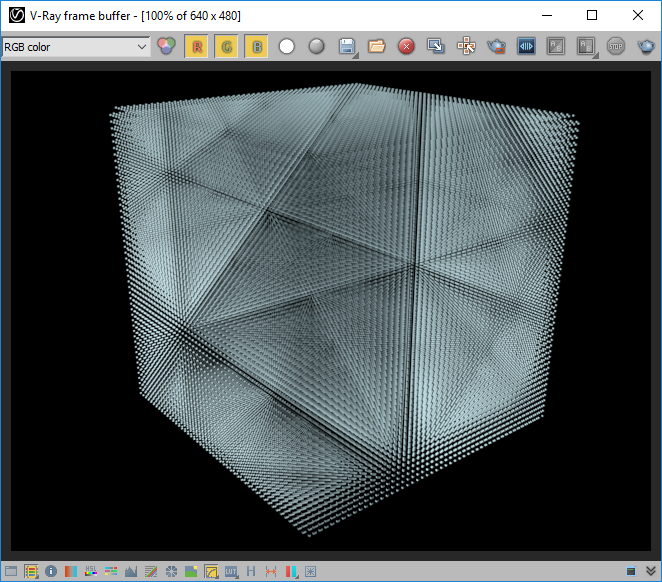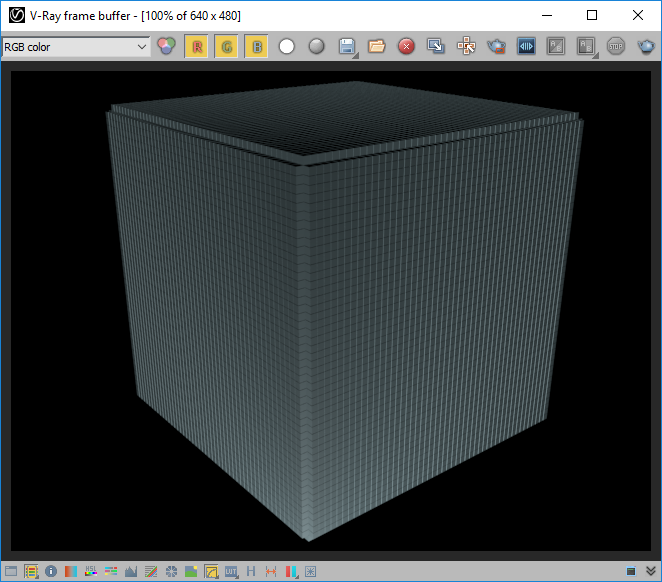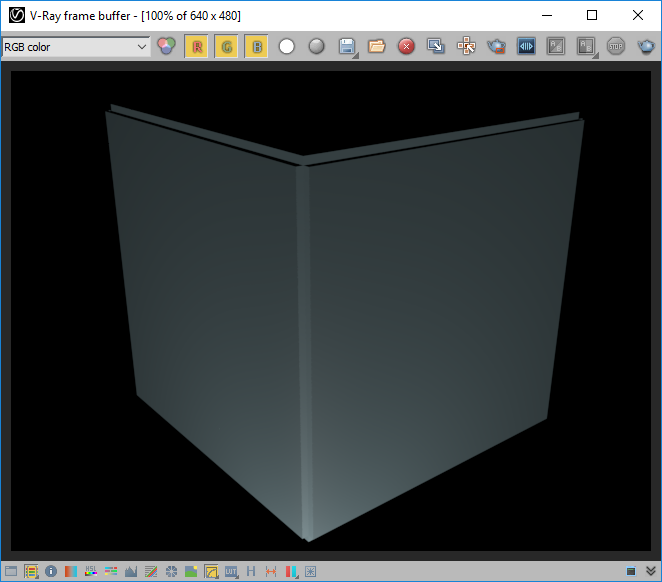V-Ray Instancing¶
Overview¶
- The V-Ray Instancing option was added in FROST MX v2.0.
- It is only used at render time if the current renderer is Chaos Group’s V-Ray v3.1 or higher.
- It is only available in Geometry meshing mode, and supports both Custom Geometry and built-in geometry shapes.
- When enabled, the geometry objects will be sent to the renderer as dynamic V-Ray Instances.
- When disabled, the geometry objects will be combined into a single large TriMesh.
How Does It Work¶
- When the V-Ray Instancing option is enabled and FROST is in Geometry meshing mode, each particle will be sent to the V-Ray renderer as a transformation matrix and relevant channels, and the actual geometry will be provided as a dynamic V-Ray inatance.
- When using the built-in Geometry primitives (Plane, Sprite, Tetrahedron, Box, Sphere), only one V-Ray instance will be allocated in memory, and will be reused for every single particle.
- When using the Custom Geometry mode, the following rules apply:
Unique V-Ray Instance Creation
- Every object on the Custom Geometry list will create a unique V-Ray Instance in memory which will then be reused by any particles assigned that shape.
- When a Custom Geometry contains an animated mesh and Animation Timing specifies a Random or GeomTime-channel controlled offset, every unique time sample will create a new V-Ray Instance in memory which will be reused by all particles with that time offset value.
V-Ray Instance Reusage
- When a particle specifies a new Material for a particle, no new V-Ray Instance will be created and the existing V-Ray Instance will be reused.
- When a particle specifies an alternative Vertex Color or Mapping channel, no new V-Ray Instance will be created and the existing V-Ray Instance will be reused.
- When a particle has custom Scaling or Orientation specified via the relevant channels or FROST controls, no new V-Ray Instance will be created and the existing V-Ray Instance will be reused.
- In other words, it is possible to reuse a very large mesh stored as a single V-Ray Instance in memory on any number of particles, where each particle has unique Position, Rotation, Scale, Material, Texture Coordinates, Vertex Colors and Velocity with minimal memory overhead.
- Only when a different mesh is requested from a different scene time, a new unique V-Ray Instance will be created for those particles that have the respective time offset.
Benefits¶
- In version of FROST prior to v2.0, the rendering of large numbers of particles replaced by geometry objects was largely dependent on the available memory.
- While render a million particles with a simple plane shape was possible, replacing each particle with a default Teapot primitive could easily use up all available memory on typical machines.
- With the introduction of V-Ray Instancing, the geometry object will be allocated in memory only once and reused a million times, thus using very little memory.
- This turns FROST into a very powerful generic scattering system.
Performance Considerations¶
- In most cases, rendering V-Ray Instances in V-Ray is slightly slower than rendering a single combined FROST TriMesh.
- For that reason, when the number of particles is relatively low and the combined TriMesh can fit in memory, it is recommended to disable the V-Ray Instancing option.
Exception To The Rule
- A known exception to this rule is when the particle cloud has a volumetric shape and the particle meshes are relatively large and occlude many of the other particles behind them.
- In this case, since the V-Ray instances are hit-tested at bounding-box level, very few particles will actually be raytraced at mesh level because they would never be “seen” by the renderer.
- See the second benchmark below.
Particle Flow Benchmark¶
- Particle Flow, VRay Advanced 3.40.02, Buckets, Min 1, Max 24 subdivs, 640x480
- Mobile Intel Core i7 M640 (Arrandale), Dual-Core, HT, 8GB RAM, Windows 10
| Particle Count | Face Count | Particle Flow | V-Ray Instancer | FROST TriMesh | FROST V-Ray Inst. | FVRI Slower |
|---|---|---|---|---|---|---|
| Box Primitive, 12 faces | ||||||
| 10,000 | 120,000 | 63sec. | 80sec. | 62sec. | 80sec. | 1.29032x |
| 100,000 | 1,200,000 | 115sec. | 156sec. | 117sec. | 156sec. | 1.33333x |
| 1,000,000 | 12,000,000 | 155sec. / 7.3GB | 194/209sec. / 5.1GB | 161sec. / 7.3GB | 182sec. / 3.1GB | 1.13043x |
| Teapot 4 segs, 1024 faces | ||||||
| 1,000,000 | 1,024,000,000 | N/A | 255sec. / 7.8GB | N/A | 317sec. / 3.1GB | 1.24314x |
| 5,000,000 | 5,120,000,000 | N/A | N/A | N/A | 476sec. / 7.4GB | N/A |
| Teapot 8 segs, 4096 faces | ||||||
| 5,000,000 | 20,480,000,000 | N/A | N/A | N/A | 470sec. / 7.4GB | N/A |
- From the above tests, we can see that
- With less than one million particles, rendering as one combined mesh is about 30% faster.
- With one million particles and a simple box shape, rendering one combined mesh with an 8GB RAM machine comes to the edge of available memory.
- At the same time, rendering one million particles in FROST with V-Ray Instancing barely uses any memory (about 1 GB of RAM over the base level).
- Replacing the box shape with a 1024 faces teapot uses the same amount of memory in FROST with V-Ray Instancing, but the render time is 1.74176x longer.
- Under the same circumstances, the native V-Ray Instancer reaches the edge of available memory, but is 1.24314x faster than FROST.
- Rendering 5 million particles with the same teapot shape brings FROST with V-Ray Instancing to the edge of available memory, but it takes only 1.50158x longer.
- Increasing the polygon count of the teapot 4 times does not affect memory usage or performance of FROST in V-Ray Instancing mode!
Krakatoa PRT Volume Benchmark¶
- PRT Volume particles in a 100x100x100 box-shaped grid with spacing of 2.0.
- Meshed with FROST using Custom Geometry, Box shape.




| Count | Radius | FROST VRI | FROST Mesh |
|---|---|---|---|
| 132,055 | 0.25 | 139 sec. | 117 sec. |
| 132,055 | 0.5 | 114 sec. | 104 sec. |
| 132,055 | 0.95 | 97 sec. | 85 sec. |
| 132,055 | 0.99 | 72 sec. | 66 sec. |
| 132,055 | 1.0 | 5 sec. | 12 sec. |
| 14,406 | 1.0 | 4 sec. | 4 sec. |
- Rendering FROST with V-Ray Instancing is generally a bit slower than rendering a single mesh.
- As mentioned earlier, once the Radius reaches 1.0 and the boxes fuse into a smooth surface, FROST with V-Ray Instancing outperforms FROST with a single mesh.
- It performs similar to rendering only the 14,406 outside particles using the PRT Volume Shell option.
Radius 1 132,055 primitives 147 sec. Radius 1 2,641,100 faces 125 sec.
Radius 2 132,055 primitives 109 sec. Radius 2 2,641,100 faces 101 sec.
Enabling V-Ray Instancing¶
- To use V-Ray Instancing, you must
- Set the Meshing Mode to Geometry
- Check the Use V-Ray Instancing option
- Make sure the current production renderer is set to V-Ray Advanced 3.1 or higher
V-Ray Instancing And Other Renderers¶
- If the Use V-Ray Instancing option is checked but the production renderer is not set to V-Ray, FROST will generate an error.
- This is to avoid potentially running out of memory if a very heavy setup was prepared for V-Ray, but the renderer was not changed by accident.
V-Ray Instancing And Viewport Meshing¶
- V-Ray Instancing is only supported at render time when the production renderer is set to V-Ray Advanced 3.1 or higher.
- However, the 3ds Max viewports will still get a single combined mesh from FROST, which can easily overwhelm the system.
- Thus, if the particle count is very high, the custom geometry is very heavy, or both, it is recommended to
- Set the Particle % value in the Viewport group of controls to a very low value (1% or less), or to
- Disable viewport meshing completely by unchecking the Enable In Viewport option in the Viewport group of controls.

